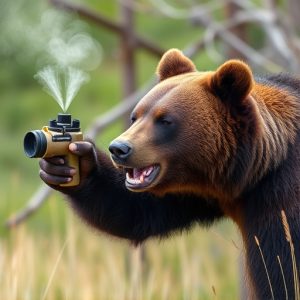Bear Spray: Understanding Active Ingredients for Optimal Wilderness Protection
Bear spray, a key tool for outdoor enthusiasts in bear-inhabited areas, uses capsaicin from chili pe…….
Bear spray, a key tool for outdoor enthusiasts in bear-inhabited areas, uses capsaicin from chili peppers (typically 2% to 4% concentration) to deter bears through a burning sensation. Effective usage involves aiming at the bear's face and eyes (sensitive areas) from a distance of 7–8 meters. Safety tips include proper storage, regular inspection, following manufacturer instructions, and avoiding pointing it at others unless necessary. Combining bear spray with good wilderness practices enhances overall safety.
“Bear spray, a powerful wilderness protection device, has become an essential tool for outdoor enthusiasts navigating rugged terrain. This article delves into the critical components of bear spray, with a focus on understanding its active ingredient percentage and efficacy. We’ll guide you through the process of selecting the right bear spray tailored to your needs, offering valuable safety tips for effective usage in diverse wilderness settings. Discover how to maximize protection and ensure a safe outdoor experience.”
- Understanding Bear Spray: The Active Ingredient and Its Efficacy
- How to Choose the Right Bear Spray Based on Active Ingredient Percentage
- Effective Usage and Safety Tips for Optimal Protection in Wilderness Settings
Understanding Bear Spray: The Active Ingredient and Its Efficacy
Bear spray is a powerful tool for personal protection against bears in wild environments, and its effectiveness relies on understanding its active ingredient. The primary active component in bear spray is capsaicin, derived from chili peppers. This compound creates a burning sensation when it comes into contact with an animal’s eyes, nose, and mouth, temporarily disorienting and driving away potential threats like bears.
The concentration of the active ingredient is key to its efficacy; typical bear sprays contain capsaicin at a strength ranging from 2% to 4%. This percentage ensures that when sprayed directly at an approaching bear, it will cause enough irritation to deter the animal without causing significant harm. The high potency of capsaicin makes bear spray a reliable and fast-acting defense mechanism for outdoor enthusiasts navigating bear country.
How to Choose the Right Bear Spray Based on Active Ingredient Percentage
When selecting bear spray, understanding the active ingredient percentage is key to ensuring its effectiveness. The primary active ingredient in bear spray is usually capsaicin, which is derived from chili peppers. This ingredient creates a burning sensation when it comes into contact with a bear’s eyes and nose, temporarily disorienting and repelling the animal. Bear sprays are available with different concentrations, typically ranging from 2% to 4%. Opting for a higher percentage (3% or 4%) is recommended as it offers greater potency and range, which can be crucial in deterring aggressive bears.
The right concentration depends on various factors like local bear behavior, the type of sprayer you choose, and personal preference. For instance, if you’re venturing into areas with known defensive bear encounters, a higher percentage can provide added protection. Always check product labels to confirm active ingredient content and understand the manufacturer’s recommendations for optimal use.
Effective Usage and Safety Tips for Optimal Protection in Wilderness Settings
When using bear spray in wilderness settings, understanding effective usage and safety tips is crucial for optimal protection. For maximum efficacy, it’s important to understand that bear spray typically contains a capsaicin-based active ingredient, with concentrations ranging from 2% to 30%. To deploy the spray effectively, aim for the bear’s face and eyes, as these areas are highly sensitive. Keep in mind that close proximity (within 7–8 meters) significantly increases the spray’s effectiveness.
Safety comes first when carrying bear spray. Store it securely in its original container, out of reach of children and pets. Regularly inspect the spray for any signs of damage or expiration. Always follow manufacturer instructions regarding usage and storage. Never point the spray at someone unless you intend to use it, as accidental deployment could cause harm to others. Additionally, bear spray is not a substitute for good wilderness practices; maintain a safe distance from bears, make noise when hiking through dense areas, and store food securely to minimize attraction.
Bear spray is an essential tool for anyone venturing into wilderness areas known for bear presence. Understanding the active ingredient percentage and proper usage techniques can significantly enhance safety. By choosing a high-quality bear spray with an effective active ingredient, such as capsaicin or oleoresin capsicum, and following safe handling practices, individuals can better protect themselves during outdoor activities. Always stay vigilant and follow local guidelines for bear encounters to ensure the best possible outcome in potentially dangerous situations.


